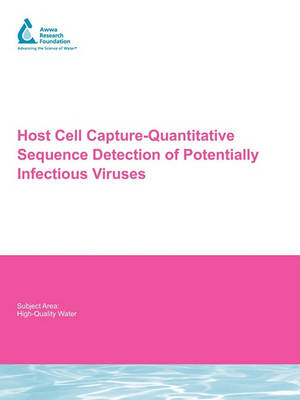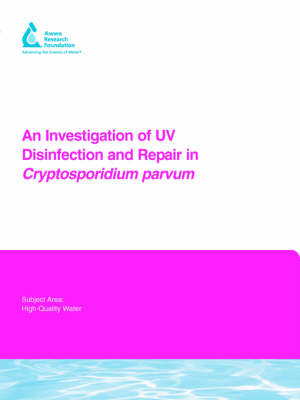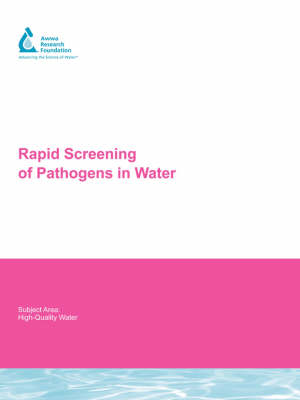Water Research Foundation Report
4 total works
Host Cell Capture-Quantitative Sequence Detection of Potentially Infectious Viruses
by George Di Giovanni, K. Mena, and L. Sifuentes
Published 14 June 2009
Conventional detection of infectious waterborne viruses involves the use of cell culture, which is time consuming and costly. Many different polymerase chain reaction (PCR) methods for the detection of viruses have been developed, with specificity, speed, and cost advantages over cell culture. However, PCR methods alone do not determine virus infectivity.
This project attempted to bridge the gap between the two detection strategies and build on their strengths. The main objective of this study was to further develop a method referred to as host cell capture quantitative sequence detection (HCC-QSD) for the rapid detection of potentially infectious viruses in water. Specific objectives were to (1) evaluate different host cell lines and capture conditions for their ability to capture enteric viruses, and (2) evaluate the ability of HCC-QSD to distinguish potentially infectious viruses from those inactivated by free-chlorine and ultraviolet light (UV). Waterborne viruses present a significant threat to human health, especially for the growing immunocompromised population. Currently, routine water monitoring and risk assessment for infectious viruses in water is hampered by the lack of rapid, specific, and cost-effective methods. In this study, significant progress was made in the further development of HCC-QSD as a rapid method for the detection and quantitation of potentially infectious viruses in water. Further evaluation of HCC-QSD with different enteric viruses and field samples will help us understand its strengths and limitations and allow its use for the routine monitoring of water for infectious viruses.
This project attempted to bridge the gap between the two detection strategies and build on their strengths. The main objective of this study was to further develop a method referred to as host cell capture quantitative sequence detection (HCC-QSD) for the rapid detection of potentially infectious viruses in water. Specific objectives were to (1) evaluate different host cell lines and capture conditions for their ability to capture enteric viruses, and (2) evaluate the ability of HCC-QSD to distinguish potentially infectious viruses from those inactivated by free-chlorine and ultraviolet light (UV). Waterborne viruses present a significant threat to human health, especially for the growing immunocompromised population. Currently, routine water monitoring and risk assessment for infectious viruses in water is hampered by the lack of rapid, specific, and cost-effective methods. In this study, significant progress was made in the further development of HCC-QSD as a rapid method for the detection and quantitation of potentially infectious viruses in water. Further evaluation of HCC-QSD with different enteric viruses and field samples will help us understand its strengths and limitations and allow its use for the routine monitoring of water for infectious viruses.
This study investigates the potential for biological repair in UV-irradiated oocysts, and it presents the results of concurrent lines of investigation to examine whether reactivation occurs following UV disinfection and also to determine if C. parvum has the genetic basis for repair. The primary objectives of the study included the following: Determine whether C. parvum oocysts of multiple isolates, irradiated with varying doses of UV light, can repair and regain infectivity under light or dark conditions using in-vitro cell culture with a human cell line. Confirm cell culture results with animal infectivity using a neonatal mouse model. Identify possible DNA repair genes in C. parvum by performing homology searches with sequence databases, polymerase chain reaction (PCR) assays, and sequencing clones from a genomic library. Measure the extent of UV-induced DNA damage by quantitative PCR. If reactivation is detected, evaluate the effects of both post-UV chemical disinfection on oocyst reactivation and determine the increased UV dosage necessary to inhibit repair. Originally published by AwwaRF for its subscribers in 2004.
Rapid Screening of Pathogens in Water
by Helene Baribeau, Paul A Rochelle, and Ricardo De Leon
Published 1 December 2006
Microbial contamination of drinking water and waterborne disease outbreaks continue to present a significant concern for the water industry. There is a need for pathogen detection methods that (1) incorporate sensitive detection and identification at the species/strain level, (2) have the ability to process many samples simultaneously, (3) involve minimal risk of false identification, (4) are adaptable, and (5) contain the capacity for some degree of automation. Molecular-based assays in high-throughput multi-well formats meet these requirements.
The demonstration of the feasibility of a microplate-based rapid screening assay indicates that the water industry should continue to pursue and fund exploratory research into the development of innovative pathogen detection methods. Such techniques may be used for routine screening of drinking water during outbreak situations, or to investigate episodes of intentional contamination. All of these situations require pathogen detection tools that can generate results, even if the results are only presumptive, in as short a time as possible. The assay may be linked to direct nucleic extraction methods so that all potential pathogens can be screened in a sample, thereby uncoupling the assay from time-consuming and often inefficient conventional microbial recovery methods.
The demonstration of the feasibility of a microplate-based rapid screening assay indicates that the water industry should continue to pursue and fund exploratory research into the development of innovative pathogen detection methods. Such techniques may be used for routine screening of drinking water during outbreak situations, or to investigate episodes of intentional contamination. All of these situations require pathogen detection tools that can generate results, even if the results are only presumptive, in as short a time as possible. The assay may be linked to direct nucleic extraction methods so that all potential pathogens can be screened in a sample, thereby uncoupling the assay from time-consuming and often inefficient conventional microbial recovery methods.
Molecular Methods for Microsporidia Detection
by D. Wolk, G. Sturbaum, R. Hoffman, C Sterling, and Marilyn M. Marshall
Published 14 October 2008
Detection of microorganisms in the U.S. water supply is crucial to the prevention of waterborne disease and bioterrorism. There is a current and critical need for optimized and standardized methods and evidence-based comparisons of methods to detect waterborne pathogens. Despite the advantages that molecular methods offer for improved sensitivity, specificity, and species confirmation, historical microscopic methods are considered to be the gold standard; molecular detection of microbes from source water is an ongoing area of research and no consensus methods currently exist. If molecular methods, such as polymerase chain reactions (PCR), are to supplement and/or replace microscopic methods, new methods must be verified and validated according to the highest standards of both sensitivity and specificity, so that false-negative and false-positive results may be avoided and evidence based risk-management decisions can be made.
The objective of this project was to optimize a robotic nucleic acid extraction method and design a real-time polymerase chain reaction (PCR) assay to detect microsporidian spores, which are currently listed on the U.S. Environmental Protection Agency's Contaminant Candidate List (CCL). To accomplish this objective, the project team compared the efficiency of the nucleic acid extraction methods with those previously used for extraction of microsporidian spores in laboratory water and feces. Using laboratory water spiked with E. intestinalis spores, robotic nucleic acid extraction methods were compared by using numeric cycle threshold output values (Ct values), which are indirectly proportional to the target DNA concentration in a real-time PCR. The Ct values were used to guide decisions for optimizing the method's performance under various experimental conditions. The method's analytical sensitivity was determined in laboratory water. An additional synthetic oligonucleotide target was then added to serve as an IC. IC Cycle threshold values (IC-Ct) were used to monitor source water samples for the presence of PCR inhibitors, which could cause false negative results. Standardized protocols were documented and the PCR method was used to detect microsporidian spores spiked into various source water samples.
The objective of this project was to optimize a robotic nucleic acid extraction method and design a real-time polymerase chain reaction (PCR) assay to detect microsporidian spores, which are currently listed on the U.S. Environmental Protection Agency's Contaminant Candidate List (CCL). To accomplish this objective, the project team compared the efficiency of the nucleic acid extraction methods with those previously used for extraction of microsporidian spores in laboratory water and feces. Using laboratory water spiked with E. intestinalis spores, robotic nucleic acid extraction methods were compared by using numeric cycle threshold output values (Ct values), which are indirectly proportional to the target DNA concentration in a real-time PCR. The Ct values were used to guide decisions for optimizing the method's performance under various experimental conditions. The method's analytical sensitivity was determined in laboratory water. An additional synthetic oligonucleotide target was then added to serve as an IC. IC Cycle threshold values (IC-Ct) were used to monitor source water samples for the presence of PCR inhibitors, which could cause false negative results. Standardized protocols were documented and the PCR method was used to detect microsporidian spores spiked into various source water samples.



